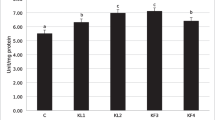Abstract
The influence of copper on embryonic development and hatching ofSepia officinalis was investigated. Copper exerts a profound effect on both hatching stage and time-to-hatching. At high copper concentrations (50–200 ppb Cu2+), the embryos hatch earlier than the controls but have a lower survival potential. No external morphological malformations were found. Whereas copper does not accumulate in the embryo or in the vitellus, it is absorbed by the envelope and/or the chorion.
Similar content being viewed by others
References
Benoit DA, Holcombe GW (1978) Toxic effects of zinc on fathead minnows (Pimephales promelas) in soft water. J Fish Biol 13:701–708
Boletzky S von (1983)Sepia officinalis. In: Boyle PR (ed) Cephalopod Life Cycles. Academic Press, London, volume 1, pp 31–52
Decleir W, Lemaire J, Richard A (1970) Determination of copper in embryos and very young specimens ofSepia officinalis. Mar Biol 5:256–258
Fioroni P (1978) Cephalopoda. In: Scidel F (ed) Morphogenese der Tiere. Fischer Verlag, Stuttgart-New York, volume 2 (G5-I), 181 pp
Ghiretti F, Ghiretti-Magaldi A, Tosi L (1959) Pathways of terminal respiration in marine invertebrates. II. The cytochrome system ofAplysia. J Gen Physiol 42:1185–1205
Ghiretti F, Violante U (1964) Ricerche sul metabolismo del rame inOctopus vulgaris. Boll Zool Torino 31:1081–1092
Holcombe GW, Benoit DA, Leonard EN (1979) Long-term effects of zinc exposures on brook trout (Salvelinus fontinalis). Trans Am Fish Soc 108:76–87
Koelliker A (1844) Entwicklungsgeschichte der Cephalopoden. Verlag Meyer und Zeller, Zürich
Konopacki M (1933) Histophysiologie du développement deLoligo vulgaris. Bull Int Acad Pol 2:51–69
Lemaire J (1971) Etude du développement embryonnaire deSepia officinalis L. (Mollusque Céphalopode), Thèse Doct., 3ème cycle. Université des Sciences et Techniques, Lille, 70 pp
Manwell C (1960) Comparative physiology: Blood pigments. Ann Rev Physiol 22:191–244
Naef A (1928) Die Cephalopoden. Monographie 35. Fauna e Flora de! Golfo di Napoli: 1–357
Orelli M von (1959) Über das Schlüpfen vonOctopus vulgaris, Sepia officinalis undLoligo vulgaris. Rev Suisse Zool 66:330343
Ranzi S (1938) Quando si forma l'emocianina nell'embrione diSepia. Ric Scient 9:631–633
Revis NJP, Valenta P, Merks AGA (1989) Heavy metal uptake by plankton and other sestoe particles. Chem Special Bioavailability 1:31–37
Rosenthal H, Sperling KR (1974) Effects of cadmium on development and survival of herring eggs. In: Blaxter JHS (ed) The Early Life History of Fish. Springer Verlag, Berlin, pp 383–396
Rosenthal H, Alderdice DF (1976) Sublethal effects of environmental Stressors, natural and pollutional, on marine fish eggs and larvae. J Fish Res Board Can 33:2047–2065
Schipp R, Hevert F (1978) Distribution of copper and iron in some central organs ofSepia officinalis (Cephalopoda). A comparative study by flameless atomic absorption and electron microscopy. Mar Biol 47:391–399
Schmidt-Nielsen K (1975) Animal Physiology, Adaptation and Environment. Cambridge University Press, 82 pp
Tompsett DH (1939)Sepia. In: RJ Daniel (ed) L.M.B.C. Memoirs on Typical British Marine Plants and Animals. University Press, Liverpool, No. XXXII, 184 pp
Valenta P, Nürnberg HW, Rützel H, Merks AGA (1984) Die Belastung der Ästuare der Westerund Oosterschelde mit okotoxischen Metallen. Vom Wasser 62:295–306
Westernhagen H von, Dethlefsen V, Rosenthal H (1975) Combined effects of cadmium and salinity on development and survival of gar pike eggs. Helgol Wiss Meeresunters 27:268–282
Wilkinson L (1988) SYSTAT: The system for statistics. Systat Inc., Evanston, IL
Author information
Authors and Affiliations
Additional information
Contribution no. 471 of the Delta Institute for Hydrobiological Research.
Rights and permissions
About this article
Cite this article
Paulij, W.P., Zurburg, W., Denucé, J.M. et al. The effect of copper on the embryonic development and hatching ofSepia officinalis L.. Arch. Environ. Contam. Toxicol. 19, 797–801 (1990). https://doi.org/10.1007/BF01183995
Received:
Revised:
Issue Date:
DOI: https://doi.org/10.1007/BF01183995




